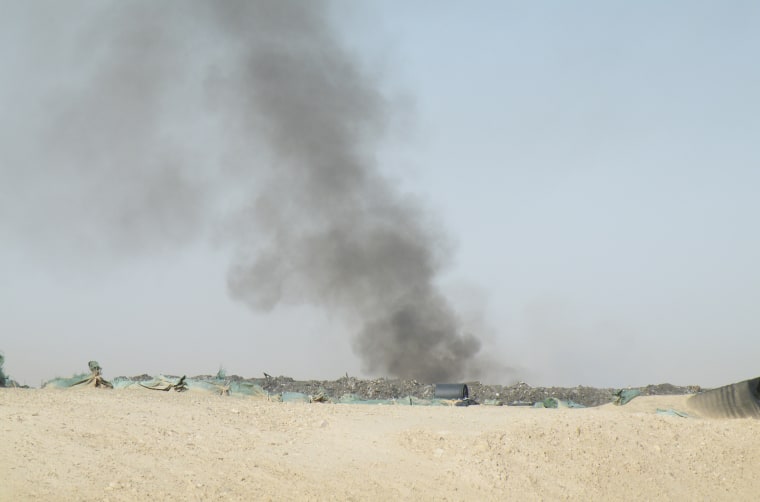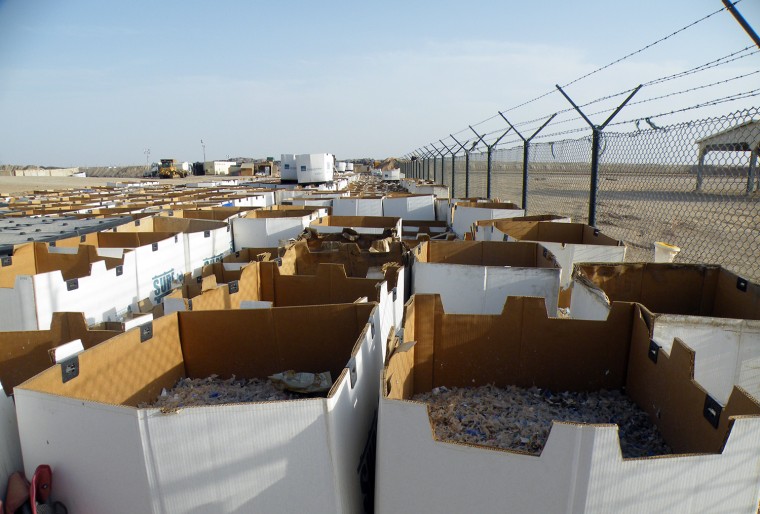
Military leaders may be endangering the health of 13,500 Marines and civilians at Camp Leatherneck in Afghanistan by burning toxic trash in an open-air pit while choosing not to safely dispose of the waste inside four new, on-base incinerators that cost $11.5 million, says a government report released Thursday.
An inspector general, authorized by Congress to oversee reconstruction efforts and spending in Afghanistan, sent an “alert letter” Thursday to the head of U.S. Central Command, Gen. Lloyd Austin, revealing that the smoldering crater violates Pentagon regulations and should be doused “as quickly as possible.”
“There are health concerns associated with breathing the smoke emissions from open-air burning,” wrote John F. Sopko, Special Inspector General For Afghanistan Reconstruction (SIGAR). “The toxic smoke from burning solid waste each day increases the long-term health risks for camp personnel, including reduced lung function and exacerbated chronic illnesses, ranging from asthma to chronic obstructive pulmonary disease.”
In response, a U.S. military official in Afghanistan said open-air burning at Camp Leatherneck is used to dispose of “non-hazardous material, such as paper products, wood and food waste."
“Burn operations are closely monitored and subject to restrictions,” said Lt. Col. Will Griffin, a spokesman for the International Security Assistance Force (ISAF). “When the cloud ceiling is too low or wind blows in the direction of Camp Leatherneck, open burn operations are halted until conditions improve and allow for more favorable burning conditions. We are not aware of any complaints at Camp Leatherneck concerning burn pit smoke.”
In January, President Barack Obama signed a law creating a registry of U.S. service members perhaps sickened or killed by burn pits used throughout Iraq and Afghanistan to destroy waste ranging from batteries to body parts. The idea behind the formal log is to track and tally veteran illnesses tied to burn pits — dubbed by some military families as “this generation’s Agent Orange.”
One advocacy group for sickened soldiers, BurnPits360.org, lists 15 service members who descended from full health to terminal diseases after serving near a burn pit. That roll includes Air Force Sgt. Jessica Sweet, who died of acute myeloid leukemia (AML) in 2009 at age 30. She served in Afghanistan. Also listed is Army Staff Sgt. Steven Ochs, who died from AML in 2008 at age 32. He served in both Afghanistan and Iraq.
“It’s like a slow torture, the result of exposing our military heroes to poison. It’s not justified. It's a crime,” said Rosie Lopez-Torres, executive director of BurnPits360. Her husband, Le Roy Torres, 40, a former Army captain, is one of the ill veterans on that list. He was diagnosed in 2010 with constrictive bronchiolitis, an irreversible disease that squeezes off airways. In 2007 and 2008, he was stationed in Balad, Iraq — home to what may have been largest military burn pit — the size of 10 football fields.
“They can't expect to burn that kind of trash and not have consequences in the end, and that consequence is life,” Rosie Lopez-Torres said Wednesday. “They shouldn’t be burning anything. This just isn't right."
But beyond possible toxic exposures at Camp Leatherneck — a Marine complex in the southwestern Helmand Province, flanked by Iran and Pakistan — the base recently invested $11.5 million to buy and install two 12-ton and two 24-ton capacity incinerators. They were meant to remove the trash safely. Yet during several visits to that post, Sopko’s inspectors found that the 12-ton incinerators were not being used to full capacity and the 24-ton incinerators were not being used at all, he noted in his letter.

The reason: A contract for their operation and maintenance had not been awarded by the U.S. military, Sopko said.
The irony: All of the solid garbage generated by Marines at Leatherneck could be processed without harm by those four chimney units if they were operated at least 18 hours each day, Sopko added. (They were manufactured to run 24 hours per day, seven days a week). And as U.S. troop reduction in Afghanistan eventually slices the Leatherneck population to 12,000 people, three of the incinerators could reduce all of the daily waste to non-toxic smoke and cinders, the letter states.
Early Thursday, ISAF spokesman Griffin said military leaders had selected a contractor to run the two larger incinerator, and that the contractor has started testing the equipment in preparation to operate the stacks "on or before July 31."
“If (military leaders operating that pit) were the ones breathing in that smoke, they definitely wouldn't be doing the burning,” Lopez-Torres said. “And if they had families or their children serving at that camp, they would say, 'Shut the burn pit down immediately.' "